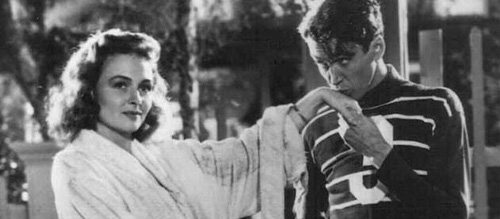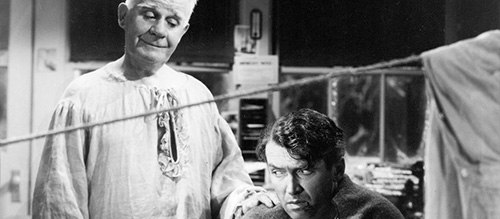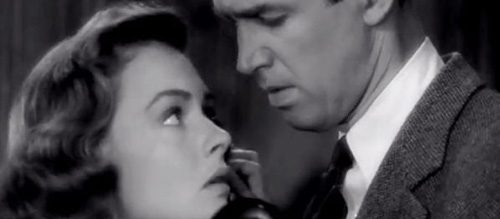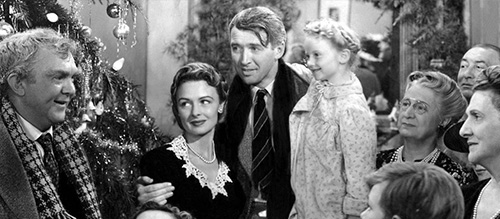‘It’s a Wonderful Life’ at 75 – Review
It’s a Wonderful Life (1946)
Director: Frank Capra
Screenwriters: Frances Goodrich, Albert Hackett, Frank Capra
Starring: James Stewart, Donna Reed, Lionel Barrymore, Thomas Mitchell, Henry Travers
Despite it bombing and falling short of its budget in its initial box office run in 1946, It’s a Wonderful Life has slowly and surely grown in popularity over the years. Mostly thanks to television syndication (through which it was annually broadcast at every yuletide), Frank Capra’s financial disaster has morphed into sell-out re-releases in cinemas across the globe. On this, its 75th birthday, It’s a Wonderful Life can enjoy its status as the favourite Christmas film of many a generation.
As the first production of the short-lived Liberty Films, a company formed by director Frank Capra, William Wyler and George Stevens, It’s a Wonderful Life was intended to be a film of conscience to soothe the traumatised masses in the immediate aftermath of the Second World War. Yet strangely its relevance hasn’t waned. In fact, adoration for this film is probably at an all time high…
For its youngest audiences, the portrayed lives of George Bailey (James Stewart) and Mary Hatch (Donna Reed) are parallel to those of their Great Grandparents (or even Great Great Grandparents), but surprisingly no element of relatability has been lost. Film is an art form, and like all great works of art, it should be an effective snapshot of the time it was created in. It’s a Wonderful Life provides an insight into the lives of these very relatives, giving a deeper understanding and appreciation of these people we may have never met but to whom we owe our very existences. The film’s continuing and growing popularity can also be attributed to its sincerity and earnestness: this isn’t only a story true to the spirit of Christmas but a film with a philosophy and message that has managed to resonate throughout the decades.

The urban myth surrounding the origins of It’s a Wonderful Life is that inspiration for the story came from a greetings card. In reality, Philip Van Doren Stern failed to get a publisher for his short story “The Greatest Gift”, so instead printed it onto Christmas cards to give to friends and family. This method of distribution eventually turned the relevant heads in Hollywood and the rights were bought by RKO. It passed through several hands and endured several rewrites resulting in a very different story to what was eventually produced, such as the starring role almost going to Cary Grant. It eventually landed in the lap of Frank Capra to become the auspicious return to Hollywood for both Capra and the film’s star, James Stewart, both of whom had dedicated themselves to the war effort, directing documentaries and training videos and serving in the US Army respectively.
It’s a Wonderful Life has become such a famous part of Hollywood’s Golden Era, its plot is familiar even to those who have never seen it. The story revolves around the character George Bailey (James Stewart) who lives in the fictional town of Bedford Falls in Upstate New York. Like millions of others, George is a typical member of the middle classes of the early 20th century in small-town America, but through the revelation of his life-story it is shown that George Bailey is anything but typical. George grew up with fierce and grand ambitions but instead of exploring the world as he had always dreamed of, he unwittingly found himself chained to a desk at a penny-counting job he hates at his late father’s Bailey Bros. Building and Loan company. This turn of events cannot be fully attributed to random unforeseen circumstances such as his father’s sudden death or falling in love with his childhood sweetheart, but instead through selflessness and moments of moral courage taken by George himself. The Bailey Building and Loan is not just a small time building society: it is the single institute that stands between Bedford Falls and the inexhaustible greedy machinations of local Millionaire, Henry F. Potter (Lionel Barrymore), and George knows this. The building society created by his father and uncle has allowed for the working class of Bedford Falls to be able to buy their own homes and escape the extortionate privately rented slums owned by Potter. And, with no one else competent enough to keep the family business going, George knows his abandonment of the company would effectively be throwing these same working masses to the wolves. He knows that Potter wouldn’t mind seeing these same people starve on the streets.
Despite having to extinguish the burning desire to stretch his wings and fly, life still isn’t too horrid for George as he lives within the warm arms of a caring community and loving family, with his wife Mary at the heart of it. This simple life marked by George’s altruism eventually takes its toll. On the fateful Christmas Eve at the epicentre of the film’s plot, $8000 dollars from the Building and Loan’s funds is misplaced, and as the bank examiner is in town, this big hole in the books will not go amiss. As George and Uncle Billy struggle to recover the missing thousands, the consequences of this accident begin to dawn on George: bankruptcy, scandal and prison. When considering his young family, this burden becomes insurmountable, leading George to contemplate ending his own life. It is at this moment in which the answer to the town’s prayers arrives in the form of the Clarence Oddbody, bringing with him the most unforgettable moments in cinema when granting George’s wish of never being born.
Underneath its Christmassy exterior, It’s a Wonderful Life is a delightfully deceptive movie filled with illusions. Although it screams originality, the story is essentially an updated version of Charles Dickens’ “A Christmas Carol” with ghostly apparitions and alternate realities to boot. It delves into dark themes such as poverty, death and suicide, yet it is considered family viewing and is famous for its many lighter moments.
In dissecting It’s a Wonderful Life to try to understand its outstanding popularity, one has to consider the writing and the philosophy that shines out from the film. It doesn’t take much research to find out that the writing process was chaotic. The story had passed through several hands by the time it reached Capra’s team, and apparently the husband and wife writing duo of Goodrich and Hackett did not get along well with Capra who secretly rewrote much of their script, much to their anger. Despite this deception, and the fact that this was the first and only time Capra had contributed to a script, the end result remains impressive, especially as it conveys a consistent philosophy throughout: celebrating the magnificence of ordinary life.
Before the war, Frank Capra’s most famous works were screwball comedies such as It Happened One Night (1934) and comedy-dramas including Mr. Deeds Goes to Town (1936) and Mr. Smith Goes to Washington (1939), each of which tend to share similar themes and characteristics to It’s a Wonderful Life: the mixing of whimsy with moments of sobriety, and of course the victory of the underdog over the big bad (which is usually a manifestation of the rich and powerful). Simple moments from life are taken and illuminated to reveal the little joys that can be found within our own lives. One such a moment comes in witnessing a soaked George and Mary walking home from George’s younger brother Harry’s high school graduation party where they accidentally fell into the swimming pool whilst dancing. Singing off-key in the streets, wearing nothing but stolen oversized clothed from lost and found, throwing rocks at an abandoned house, this is where George and Mary’s love begins to flower, as it has in similar moments for normal people throughout history.
What differs It’s a Wonderful Life to its pre-war counterparts is: despite its reputation as an uplifting and inspiring film, a very dark tone bleeds throughout. Even in comparison to Mr. Smith Goes to Washington in which the titular Smith is pitted against the corrupt system of the American political machine, George Bailey’s struggles against Mr Potter and indeed the evils of ordinary life feels so much more harrowing. No longer do the stakes within Capra’s movies feel as if they are there for spectacle, they instead appear to be a reflection of the horror and tragedy of reality. Capra even uses comedy to consolidate George’s pathetic circumstances, such as in the moment George realises Clarence, his supposed guardian angel, is only a second-class one.

“Well, you look about the kind of angel I’d get.”
Additionally, his expert timing is used to induce painful whiplash. George and Mary’s aforementioned wicked fun on the streets of Bedford Falls is cut drastically short as George’s family calls him home as his Father had just suffered a stroke. How true to the diametric highs and lows of real life.
Considering the time in which the film was made, it is not surprising that Capra’s work experienced such a tonal shift: Capra, alongside everyone else in the world, would have been shocked and appalled beyond belief by the atrocities that were unearthed during the war. The depiction of such exquisite despair turning into hope and joy required expertise beyond just writing – Capra’s direction drew upon all elements of production to create this masterpiece. Standing as a very expensive independent movie (notably, the set for Bedford Falls is still one of the largest film sets ever assembled with the main street being 300 yards long), it was in no small part Capra’s creativity that assembled a film that feels oddly modern.
Now a popular trope of contemporary cinema, over half of It’s a Wonderful Life is told in flashback, a fairly uncommon tactic only used by the boldest of directors of the time. Its use here gives us an all-encompassing bird’s eye (or heaven’s) view of George’s life, creating an act of deception in which a 2 hour run-time feels like a man’s entire life story. This narrative structure also ensures that we can’t help but to fall in love with George as we witness his private moments of frustration and anger, each highlighting the cost of every one of his sacrifices. Capra also indulged in the use of freeze frames before they were popularised – in that era of filmmaking, freeze-frames were used as part of a fantasy sequence, such as when time is frozen in A Matter of Life and Death (1946) as opposed to an editing technique. Capra used it as an opportunity to emphasise important details within the story, specifically through the medium of the unseen Joseph narrating George’s life to Clarence. There hasn’t been a film with narration released in the three quarters of a century since that doesn’t use the same technique.
Another first-time innovation worthy of note, especially because of its unexpected visceral power, is the snow. It’s a Wonderful Life was filmed in the summer on a sound stage, so of course the snow isn’t real. Before 1946, falling snow seen on film was cornflakes painted white, and as one would expect the result was a lot of unwanted sound. Capra was very keen on recording the film’s sound live on set, and as such a way to make silent snow had to be found. The answer to Capra’s demand came in the shape of a mixture of foamite, soap and water being pumped through a wind machine at high pressure. Is there a more peaceful, natural silence than a winter’s night where the noise of the world is muffled by the fall of snow? The creation of this silent snow helped to heighten the emotion of what is now one of the most beloved movie scenes of all time: after wishing he was never born, George eventually wins his life back after praying for it from God; the answer to his prayer comes with the silent falling of snow that goes unnoticed to George, representing that he is now back in his own reality.
“I wanna live again. I wanna live again. Please, God, let me live again.”
Cinematic perfection.
Of course, Capra’s greatest innovation in directing It’s a Wonderful life was hewing out the performance of the movie’s stars, most notably those of Donna Reed and James Stewart. The influence of the Second World War on the pair’s performances is too vast to encapsulate within this review, and not enough credit can be given to these actors for utilising their own possibly traumatic experiences from that conflict to give such raw and truthful renderings of their characters. The pair’s chemistry with each other represented the two major emotions found in the war’s aftermath: George is the jaded cynic contemplating whether life will be the same again and Mary is the life-affirming optimist within this new found world. With this dynamic, Capra was generous in letting his actors explore their feelings. James Stewart’s return to the big screen did show a notable difference in performance: still very much the All-American Everyman, he was not quite as wide-eyed and naïve as his popular pre-war roles in the likes of Mr. Smith Goes to Washington and Destry Rides Again (1939). This more brooding appearance would eventually lead to the much darker roles he took on under Alfred Hitchcock. The actor himself had doubts about being able to perform certain scenes after his war experience, but these doubts turned out to be unfounded after reassurances from Capra who would let Stewart get his teeth stuck into a scene. By allowing the actors to run away with their own emotions, one of the most electrically charged kiss scenes was born as Stewart and Reed embrace over a fateful phone call. Critics to this day are still surprised it got through the censors.

Capra’s instincts and emotional sensitivity would especially pay off in creating It’s a Wonderful Life‘s biggest tear-jerking moment, in which George Bailey finally crumbles and resorts to prayer over a drink in a bar. Stewart reportedly became overcome with genuine emotion at invoking help from the “Divine Father” and is obviously and unabashedly crying. Capra loved it but had unfortunately filmed the whole thing on a long shot. Stewart had refused another take, knowing that he wouldn’t be able to convincingly act out that scene again, so at great cost Capra had that scene blown up. It remains transcendent to this day.
For a film that unabashedly deals in fantasy and the divine, there is oddly enough no Deus Ex Machina moment. When George returns home joyfully and triumphantly, he hasn’t had his problem’s magically fixed by Clarence. He has merely been returned to his own reality (with $8000 still missing). Furthermore, this isn’t a “be grateful with what you have” kind of story. Indeed, George has been shown the worth of his life by seeing the goodness that his generosity and integrity has brought to his community, and it is indeed these acts of goodness which save him. By helping others in need, those whom he has served have come to help him in his time of need, with it all coming to fruition in the finale as the townspeople of Bedford Falls fill the Bailey home, bringing George money but more importantly their love.
This is not an empty message. In its 75 years of existence, It’s a Wonderful Life’s truth still holds up. Despite the omnipresent darkness of the last few years, we have seen time and time again that we are capable of helping each other. People have fed the hungry, rescued those in peril, clapped for carers, looked after the sick and dying. There is always a danger that the humans that do this giving become weary as it feels like their work is all for naught, or times when it feels too difficult to fight the continuing corruption of those in power, but despite the Potters and Johnsons of this world, the wisdom of It’s a Wonderful Life still rings true.
For all those who have made sacrifices to help others in need, remember our own lives touch so many lives – you may not realise it, but the good you do has a huge and far-reaching impact, the absence of which would be keenly felt. “No man is a failure who has friends.”
24/24


